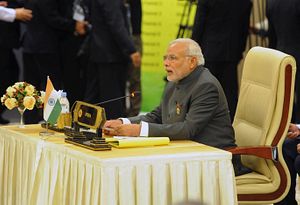In the face of unprecedented uncertainties in the Indo-Pacific, mostly driven by China’s rise, India’s outreach efforts to ASEAN has accelerated. The effort has included an increased number of security consultations, political dialogues, and joint military exercises with Southeast Asian countries.
All 10 ASEAN leaders were in India for the 69th Republic Day celebrations, a first. The usual pattern has been to invite one foreign leader for these celebrations. The invitation was indicative of the importance India attaches to the strategic engagement with the ASEAN countries.
Now, in another indicator of India’s stepped up outreach to the region, India is holding another iteration of a large joint military exercise with Malaysia. The military exercise, titled “Harimau Shakti,” is being held in Malaysia from April 30 to May 13. The joint combat exercise is meant to create greater synergy and interoperability between the two armed forces.
The Indian defense ministry, in a statement, said that the exercise is aimed at “bolstering cooperation and coordination between the armed forces of both the nations and to share the expertise of both the contingents in conduct of counter-insurgency operations in jungle terrain.” The 4 Grenadiers Battalion of the Indian Army and 1 Royal Ranjer Regiment and the Royal Malay Regiment from the Malaysian Army are participating, and, with a focus on tactical operations in jungle warfare, the two sides will engage in joint training, planning and executing a series of training activities in the dense forests of Sengai Perdik, Hulu Langat, Malaysia.
These exercises will refine and sharpen the operational counterinsurgency tactics of both the armies, but the larger aim is clearly to boost the strategic partnership between the two countries. Though this is not the first joint military exercise in this series, New Delhi has claimed that “(T)his is the first instance wherein a joint training exercise of this magnitude involving Indian and Malaysian soldiers is being organized on Malaysian soil.”
The two sides have had a history of military cooperation, and became strategic partners in 2010. In the defense arena, the two sides have engaged in exchange of information on training, maintenance and technical support for Su-30 fighter aircraft, in addition to the establishment of a “Systems School” for the fighters at the Gong Kedak airbase. The Indian Air Force had also stationed a team in Malaysia between 2008 and 2010 as Malaysia was inducting and starting the operation of the Su-30 MKM fighter aircraft, which they had just procured. Earlier in the 1990s, the Malaysian Air Force had sent its pilots and technicians to India to train on the Mig-29 Fulcrums.
Bilateral naval cooperation has also remained strong, and the Indian Navy regularly participates along with other external partners in the Langkawi International Maritime and Aerospace Exhibition in Malaysia. Port visits by Indian Navy and Coast Guard ships are also of significance especially in the context of the increasing Chinese naval footprint in in the Indian Ocean. India and Malaysia have also established a mechanism for information sharing information for Humanitarian Assistance and Disaster Relief (HADR) and white shipping.
The relatively increased emphasis on the defense domain in India’s ties with Southeast Asian states including Malaysia bears watching from a historical perspective. When India’s Look East Policy was announced in the early 1990s, India’s focus was limited mostly to economic and trade issues, and Singapore was the focal point within ASEAN. The economic focus is still important, including in India’s ties with Malaysia. Najib during his trip to India in 2017 noted that Malaysia had not tapped into realizing “the full potential of the bilateral relationship” but “is belatedly showing interest in the Indian economy to some extent.”
But the strategic aspects of the relationship have also clearly become more important over time as “Look East” has begun to be translated more into “Act East.'” Ties with individual countries in the region such as Indonesia and Malaysia are gaining greater traction and visibility. Malaysia and India, for one, have emphasized their commitment to maintaining open seas and freedom of navigation, on the basis of the principles enshrined in the United Nations Convention on the Law of the Sea (UNCLOS). The two have also reiterated their call to all claimant parties to avoid using unilateral measures and find peaceful solutions to disputes involving sovereignty and territorial integrity. As China becomes increasingly active in India’s backyard in South Asia, New Delhi can be expected to focus equally on China’s backyard in Southeast Asia.

































